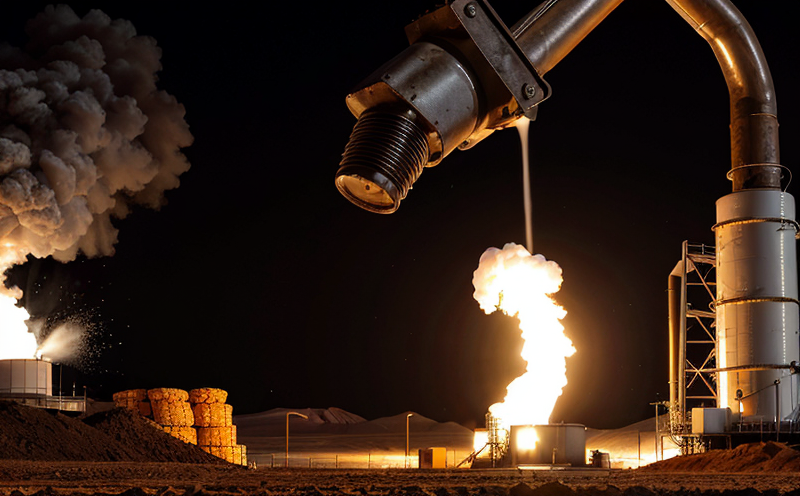ISO 1928 Solid Mineral Fuels Gross Calorific Value Testing
The ISO 1928 standard provides a method to determine the gross calorific value of solid mineral fuels. This test is crucial for ensuring that fuel products meet specified quality standards, enabling accurate comparison between different suppliers and aiding in regulatory compliance.
Understanding the gross calorific value (GCV) helps in evaluating the energy content of coal and other solid fuels, which is essential for optimizing combustion processes and predicting heat output. This information is vital for industries such as power generation, metallurgy, and chemical processing, where precise fuel characteristics are critical to operational efficiency.
The testing process involves several steps, starting with sample preparation. The specimen must be in a form that allows for accurate calorimetric analysis, typically crushed or ground down to a specific particle size range. Once prepared, the sample is placed into a bomb calorimeter along with an excess of oxygen. The fuel is ignited, and the combustion process is allowed to proceed until all combustible materials are consumed.
During this process, heat is released which raises the temperature of the calorimeter system. The difference in temperature before and after the combustion reaction indicates the amount of heat produced by the fuel, from which the gross calorific value can be calculated using specific formulas provided in ISO 1928. This test not only provides insights into the energy content but also helps in identifying potential issues with fuel quality.
The accuracy of this testing method is paramount for ensuring reliable results. Factors such as sample preparation, oxygen purity, and calorimeter calibration significantly influence the final result. Therefore, adherence to strict protocols and use of high-quality equipment are essential. Compliance with ISO 1928 ensures that tests conducted in different laboratories yield consistent and comparable results.
By leveraging this testing method, organizations can enhance their operational efficiency by optimizing fuel usage. For instance, power plants can fine-tune their boilers to achieve maximum energy output while minimizing waste. Similarly, industrial facilities can ensure they are purchasing fuels that meet the required specifications, thereby reducing costs associated with poor quality fuel.
Moreover, compliance with ISO 1928 is crucial for meeting regulatory requirements and ensuring product quality. This standard plays a vital role in facilitating international trade of solid mineral fuels by providing a universally accepted method for determining calorific value.
Applied Standards
| Standard Number | Description |
|---|---|
| ISO 1928:2017 | Determination of gross calorific value by means of a bomb calorimeter |
| ASTM D5364-19 | Determination of gross calorific value of solid mineral fuels by bomb calorimeter |
| EN ISO 1928:2017 | Determination of gross calorific value by means of a bomb calorimeter |
The application of these standards ensures that the testing process is consistent and reliable. The use of internationally recognized protocols enhances credibility in trade negotiations and supports quality assurance programs.
Benefits
Determining the gross calorific value of solid mineral fuels through ISO 1928 offers numerous advantages. Firstly, it provides a standardized method for assessing fuel quality, which is essential for ensuring consistent performance across different suppliers. This standardization facilitates fair trade practices and helps in making informed purchasing decisions.
Secondly, compliance with this test ensures that the energy content of fuels meets regulatory requirements, thereby reducing legal risks associated with non-compliance. Thirdly, it allows for better management of fuel inventories by providing accurate data on calorific value, which aids in optimizing storage and usage.
Moreover, ISO 1928 testing supports environmental sustainability initiatives by enabling the identification of fuels that offer higher energy yields per unit mass. This can lead to reduced emissions from combustion processes, contributing positively to global efforts towards cleaner energy solutions.
In conclusion, adhering to ISO 1928 not only enhances operational efficiency but also promotes transparency and trust within supply chains. By ensuring that all parties involved in the trade of solid mineral fuels adhere to this standard, it fosters a more reliable and efficient market environment.
Why Choose This Test
The ISO 1928 gross calorific value testing is an indispensable tool for industries reliant on solid mineral fuels. The accuracy and reliability of these tests make them particularly valuable for several reasons:
- Consistency in Quality: Ensures that all fuel samples are tested under the same conditions, providing consistent results across different batches or suppliers.
- Regulatory Compliance: Helps organizations meet stringent regulatory standards and avoid potential legal issues.
- Optimized Operations: Provides crucial data that can be used to optimize fuel consumption, thereby reducing costs and improving efficiency.
- Enhanced Reputation: Demonstrates commitment to quality assurance, which builds trust with customers and stakeholders.
- Sustainable Practices: Supports environmental goals by enabling the selection of fuels that offer higher energy yields per unit mass.
These benefits underscore why ISO 1928 testing is a preferred choice for industries seeking to ensure top-tier fuel quality and operational efficiency.





